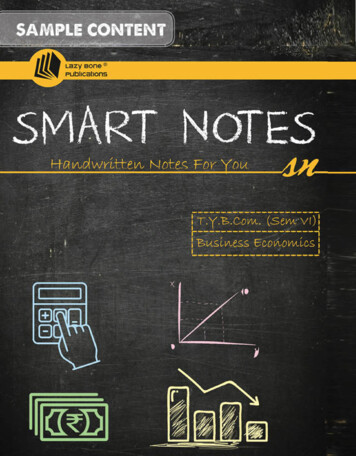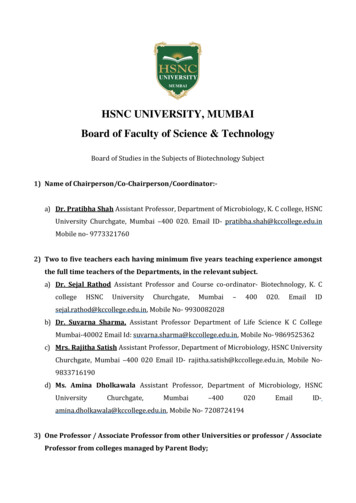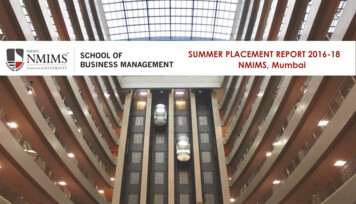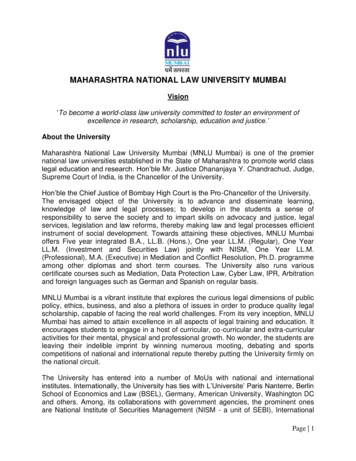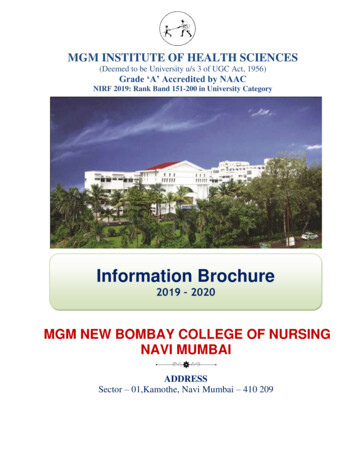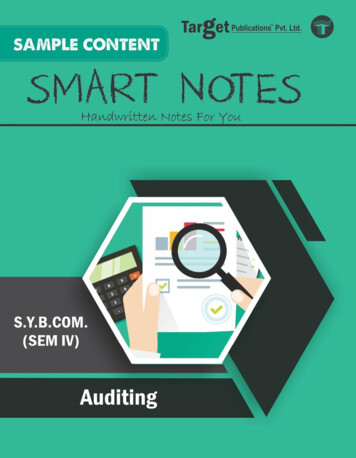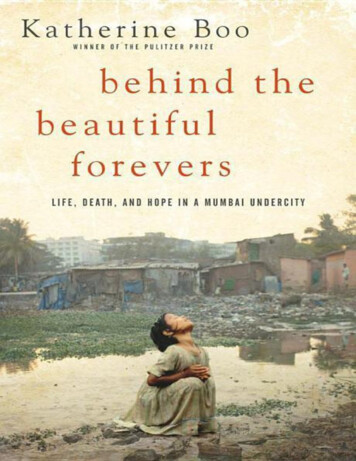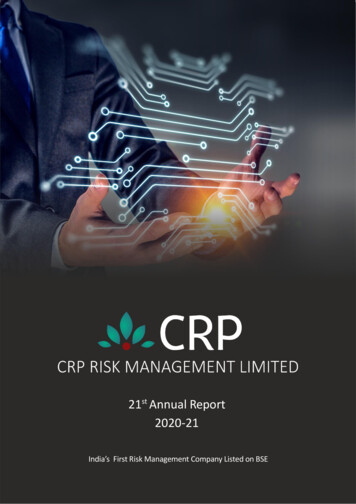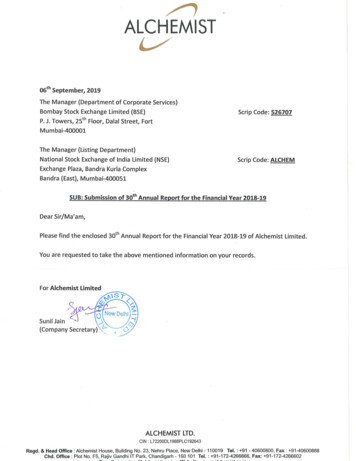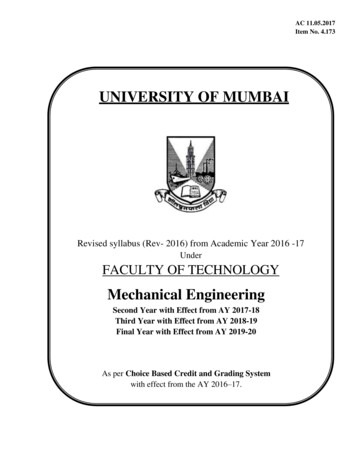
Transcription
AC 11.05.2017Item No. 4.173UNIVERSITY OF MUMBAIRevised syllabus (Rev- 2016) from Academic Year 2016 -17UnderFACULTY OF TECHNOLOGYMechanical EngineeringSecond Year with Effect from AY 2017-18Third Year with Effect from AY 2018-19Final Year with Effect from AY 2019-20As per Choice Based Credit and Grading Systemwith effect from the AY 2016–17.
Co-ordinator, Faculty of Technology Preamble:To meet the challenge of ensuring excellence in engineering education, the issue of quality needs to beaddressed, debated and taken forward in a systematic manner. Accreditation is the principal means of qualityassurance in higher education. The major emphasis of accreditation process is to measure the outcomes of theprogram that is being accredited. In line with this Faculty of Technology of University of Mumbai has taken alead in incorporating philosophy of outcome based education in the process of curriculum development.Faculty of Technology, University of Mumbai, in one of its meeting unanimously resolved that, each Board ofStudies shall prepare some Program Educational Objectives (PEOs) and give freedom to affiliated Institutes toadd few (PEOs). It is also resolved that course objectives and course outcomes are to be clearly defined foreach course, so that all faculty members in affiliated institutes understand the depth and approach of course tobe taught, which will enhance learner’s learning process. It was also resolved that, maximum senior facultyfrom colleges and experts from industry to be involved while revising the curriculum. I am happy to state that,each Board of studies has adhered to the resolutions passed by Faculty of Technology, and developedcurriculum accordingly. In addition to outcome based education, semester based credit and grading system isalso introduced to ensure quality of engineering education.Choice based Credit and Grading system enables a much-required shift in focus from teacher-centric to learnercentric education since the workload estimated is based on the investment of time in learning and not inteaching. It also focuses on continuous evaluation which will enhance the quality of education. University ofMumbai has taken a lead in implementing the system through its affiliated Institutes and Faculty of Technologyhas devised a transparent credit assignment policy and adopted ten points scale to grade learner’s performance.Credit assignment for courses is based on 15 weeks teaching learning process, however content of courses isto be taught in 12-13 weeks and remaining 2-3 weeks to be utilized for revision, guest lectures, coverage ofcontent beyond syllabus etc.Choice based Credit and grading system is implemented from the academic year 2016-17 through optionalcourses at department and institute level. This will be effective for SE, TE and BE from academic year 201718, 2018-19 and 2019-20 respectively.Dr. S. K. UkarandeCo-ordinator,Faculty of Technology,Member - Academic CouncilUniversity of Mumbai, MumbaiUniversity of Mumbai,B. E. (Mechanical Engineering), Rev 20162
Chairman’s Preamble:Engineering education in India is expanding and is set to increase manifold. The major challenge in the currentscenario is to ensure quality to the stakeholders along with expansion. To meet this challenge, the issue ofquality needs to be addressed, debated and taken forward in a systematic manner. Accreditation is the principalmeans of quality assurance in higher education and reflects the fact that in achieving recognition, the institutionor program of study is committed and open to external review to meet certain minimum specified standards.The major emphasis of this accreditation process is to measure the outcomes of the program that is beingaccredited. Program outcomes are essentially a range of skills and knowledge that a student will have at thetime of graduation from the program. In line with this Faculty of Technology of University of Mumbai hastaken a lead in incorporating the philosophy of outcome based education in the process of curriculumdevelopment.As the Chairman, Board of Studies in Mechanical Engineering of the University of Mumbai, I am happy tostate here that, the Program Educational Objectives for Undergraduate Program were finalized in a brainstorming sessions, which was attended by more than 40 members from different affiliated Institutes of theUniversity. They are either Heads of Departments or their senior representatives from the Department ofMechanical Engineering. The Program Educational Objectives finalized for the undergraduate program inMechanical Engineering are listed below;1. To prepare the Learner with a sound foundation in the mathematical, scientific and engineeringfundamentals2. To motivate the Learner in the art of self-learning and to use modern tools for solving real life problems3. To inculcate a professional and ethical attitude, good leadership qualities and commitment to socialresponsibilities in the Learner’s thought process4. To prepare the Learner for a successful career in Indian and Multinational OrganisationsIn addition to Program Educational Objectives, for each course of the program, objectives and expectedoutcomes from a learner’s point of view are also included in the curriculum to support the philosophy ofoutcome based education. I strongly believe that even a small step taken in the right direction will definitelyhelp in providing quality education to the major stakeholders.Dr. S. M. KhotChairman, Board of Studies in Mechanical Engineering, University of MumbaiUniversity of Mumbai,B. E. (Mechanical Engineering), Rev 20163
Program Structure forB.E. in Mechanical EngineeringUniversity of Mumbai(With Effect from 2017-2018)Semester IIITeaching SchemeCredits Assigned(Contact Hours)TheoryPractTheoryPractTotalMEC301Applied Mathematics rength of Materials*04-04-04MEC304Production Process I*04-04-04MEC305Material Technology*03-03-03MEL301Computer Aided Machine Drawing*-2 4-0303MEL302Strength of Material*-02-0101MEL303Material Technology*-02-0101MEL304Machine Shop Practice I*-04-0202Total1914190726Examination SchemeTheoryCourseInternal AssessmentExamCourse NameTerm Pract/CodeTotalEnd Sem DuratiWorkOralExamonTest1Test 2Avg(Hrs)MEC301Applied Mathematics 3--100MEC303Strength of Materials*2020208003--100MEC304Production Process I*2020208003--100MEC305Material Technology*2020208003--100Computer Aided MachineMEL301-----5050100Drawing*MEL302Strength of Material*-----252550MEL303Material Technology*-----25-25MEL304Machine Shop Practice I*-----50-50Total10040015075725* Common with Automobile Engineering** Common with Automobile Engineering, Production Engineering and Civil Engineering Theory for entire class to be conductedCourseCodeCourse NameUniversity of Mumbai,B. E. (Mechanical Engineering), Rev 20164
Course CodeMEC301Course NameApplied Mathematics III**Credits04Objectives1. To provide sound foundation in the mathematical fundamentals necessary to formulate, solve andanalyse engineering problems.2. To study the basic principles of Laplace Transform, Fourier Series, Complex variables.Outcomes: Learner will be able to 1. Demonstrate the ability of using Laplace Transform in solving the Ordinary Differential Equationsand Partial Differential Equations2. Demonstrate the ability of using Fourier Series in solving the Ordinary Differential Equations andPartial Differential Equations3. Solve initial and boundary value problems involving ordinary differential equations4. Identify the analytic function, harmonic function, orthogonal trajectories5. Apply bilinear transformations and conformal mappings6. Identify the applicability of theorems and evaluate the contour integrals.ModuleDetailed ContentsLaplace Transform1.1 Function of bounded variation, Laplace Transform of standard functions such as 1,Hrst n , e at , sin at , cos at , sinh at , cosh at1.2 Linearity property of Laplace Transform, First Shifting property,Second Shifting property, Change of Scale property of L.T. (without proof)1t d n f t f t L t n f t , L ,Lfudu , L Laplace Transform. of Periodic functionsn t 0 dt 121.3 Inverse Laplace Transform: Linearity property, use of theorems to find inverse LaplaceTransform, Partial fractions method and convolution theorem(without proof).1.4 Applications to solve initial and boundary value problems involving ordinary differentialequations with one dependent variableComplex variables:2.1 Functions of complex variable, Analytic function, necessary and sufficient conditions fof z to be analytic (without proof), Cauchy-Riemann equations in polar coordinates.232.2 Milne- Thomson method to determine analytic function f z when it’s real or imaginaryor its combination is given. Harmonic function, orthogonal trajectories2.3 Mapping: Conformal mapping, linear, bilinear mapping, cross ratio, fixed points andstandard transformations such as Rotation and magnification, inversion and reflection,translationComplex Integration:3.1 Line integral of a function of a complex variable, Cauchy’s theorem for analyticfunctions(without proof)Cauchy’s integral formula (without proof))Singularities and poles:3.2 Taylor’s and Laurent’s series development (without proof)3.3 Residue at isolated singularity and its evaluation3.4 Residue theorem, application to evaluate real integral of type2 f cos , sin d , &0408 f x dx Fourier Series:4.1 Orthogonal and orthonormal functions, Expressions of a function in a series of orthogonalfunctions. Dirichlet’s conditions. Fourier series of periodic function with period2 and 2lUniversity of Mumbai,08B. E. (Mechanical Engineering), Rev 20161010
4.2 Dirichlet’s theorem(only statement), even and odd functions, Half range sine and cosineseries,Parsvel’s identities (without proof)4.3 Complex form of Fourier seriesPartial Differential Equations:5.1. Numerical Solution of Partial differential equations using Bender-Schmidt ExplicitMethod, Implicit method (Crank- Nicolson method).5.2. Partial differential equations governing transverse vibrations of an elastic string its solutionusing Fourier series.5.3. Heat equation, steady-state configuration for heat flow5.4. Two and Three dimensional Laplace equationsCorrelation and curve fitting6.1. Correlation-Karl Pearson’s coefficient of correlation- problems, Spearman’s Rankcorrelation problems, Regression analysis- lines of regression (without proof) –problems6.2. Curve Fitting: Curve fitting by the method of least squares- fitting of the curves of theform, y ax b, y ax2 bx c and y aebx560905Assessment:Internal Assessment for 20 marks:Consisting Two Compulsory Class TestsFirst test based on approximately 40% of contents and second test based on remaining contents (approximately40% but excluding contents covered in Test I)End Semester Examination:Weightage of each module in end semester examination will be proportional to number of respective lecturehours mentioned in the curriculum.1. Question paper will comprise of total six questions, each carrying 20 marks2. Question 1 will be compulsory and should cover maximum contents of the curriculum3. Remaining questions will be mixed in nature (for example if Q.2 has part (a) from module 3 thenpart (b) will be from any module other than module 3)4. Only Four questions need to be solved.References:1.2.3.4.5.Higher Engineering Mathematics, Dr B. S. Grewal, Khanna PublicationAdvanced Engineering Mathematics, E Kreyszing, Wiley Eastern LimitedHigher Engineering Mathematics, B.V. Ramana, McGraw Hill Education, New DelhiComplex Variables: Churchill, Mc-Graw HillIntegral Transforms and their Engineering Applications, Dr B. B. Singh, Synergy Knowledgeware,Mumbai6. Numerical Methods, Kandasamy, S. Chand & CO7. Fundamentals of mathematical Statistics by S.C. Gupta and KapoorUniversity of Mumbai,B. E. (Mechanical Engineering), Rev 201611
Course CodeMEC302Course NameThermodynamics*Credits04Objectives1. To familiarize the concepts of Energy in general and Heat and Work in particular2. To study the fundamentals of quantification and grade of energy3. To study the effect of energy transfer on properties of substances in the form of charts and diagrams4. To familiarize application of the concepts of thermodynamics in vapour power, gas power cyclesOutcomes: Learner will be able to 1. Demonstrate application of the laws of thermodynamics to wide range of systems.2. Write steady flow energy equation for various flow and non-flow thermodynamic systems3. Compute heat and work interactions in thermodynamics systems4. Demonstrate the interrelations between thermodynamic functions to solve practical problems.5. Use steam table and mollier chart to compute thermodynamics interactions6. Compute efficiencies of heat engines, power cycles etc.Module01020304Detailed ContentsHrsBasic Concepts & definitions:Thermodynamics and its importance, Macroscopic and Microscopic view point, Concept ofContinuum, Thermodynamic System, Surrounding and Boundary, Control Volume approachand Systems approach, Equilibrium – Thermal ,Chemical, Mechanical and thermodynamic,Pure Substance, Property – Intensive and Extensive, State, Path, Process and Cycle. PointFunction and Path Function, Quasi Static Process and processes like Isobaric, Isochoric,Isothermal, Polytropic Process, Temperature and different scales, Zeroth Law ofThermodynamics, Energy, sources of energy; forms of energy, Energy transfer by work andforms of work ; free Expansion, Energy transfer by heat ; Adiabatic Process, Equations ofstate, Ideal gas Equation-; Specific gas constant and Universal Gas ConstantFirst Law of Thermodynamics:Relation between Heat and Work- Joules Constant, First law of thermodynamics for a cyclicprocess, First law of thermodynamics for a closed system undergoing a process, Conservationprinciple, First Law of Thermodynamics applied to open system – Steady Flow EnergyEquation, Perpetual motion Machine of First kind, Application of first law of thermodynamicsto closed system or Non flow Process, Application of first law of thermodynamics to OpenSystems like Steam Nozzle, Boiler, Steam Turbine, Pump, Heat Exchanger, ThrottlingProcess – Joules Thompson Coefficient and its significanceSecond Law of Thermodynamics:Limitation of first law of thermodynamics, Thermal Reservoir – Source and Sink, Concept ofHeat Engine, Heat Pump and Refrigerator, Second law of thermodynamics – Kelvin Planckand Clausius Statements. Equivalence of Clausius and Kelvin Planck Statement, Reversibleand Irreversible Process. Causes of Irreversibility, Perpetual Motion Machine of SecondKind, Need of Carnot theorem and its corollaries, Carnot cycle, Thermodynamic TemperatureScale and its equivalence with Ideal Gas ScaleEntropy:Clausius Inequality, Clausius Theorem, Entropy is Property of a system, Isentropic Process,Temperature Entropy Plot and its relationship with heat interactions, Entropy Principle,Entropy change During a Process. Interpretation of concept of entropyThermodynamic Relations:Reciprocal Relation, Cyclic Relation Property relations, Maxwell Relations, TdS equations,Heat capacity relations, Volume Expansivity, Isothermal Compressibility, ClausiusClapeyron EquationAvailability:University of Mumbai,B. E. (Mechanical Engineering), Rev 20161208070710
0506High grade and Low Grade Energy, Available and Unavailable Energy, Dead State, Availableenergy with respect to a process and a cycle, Decrease of Available Energy When heat istransferred through a finite temperature Difference, Second Law efficiencyProperties of Pure Substance:Pure substance and Phase changes: Phase change processes of pure substance, Propertydiagrams for phase change process (T-v, T-s and p-h diagrams), Understanding of SteamTable and Mollier chart with suitable examples.Compressors:Reciprocating Air Compressor, Single stage compressor – computation of work done,isothermal efficiency, effect of clearance volume, volumetric efficiency, Free air delivery,Theoretical and actual indicator diagram,Multistage compressors – Constructional details of multistage compressors, Need ofmultistage, Computation of work done, Volumetric efficiency, Condition for maximumefficiency, Inter cooling and after cooling (numerical), Theoretical and actual indicatordiagram for multi stage compressorsRotary Air Compressors- Classification, Difference between compressors and blowers,Working and constructional details of roots blower, Screw type and vane type compressorsVapour Power cycle:Carnot cycle and its limitations as a vapour cycle, Rankine cycle with different turbine inletconditions, Mean temperature of heat addition, Methods to improve thermal efficiency ofRankine cycle – Reheat cycle and Regeneration Cycle.Gas Power cycles:Assumptions of Air Standard Cycle, Otto cycle, Diesel Cycle and Dual cycle, Brayton Cycle,Sterling Cycle and Ericsson Cycle and Lenoir cycle and Atkinson cycle0810Assessment:Internal Assessment for 20 marks:Consisting Two Compulsory Class TestsFirst test based on approximately 40% of contents and second test based on remaining contents (approximately40% but excluding contents covered in Test I)End Semester Examination:Weightage of each module in end semester examination will be proportional to number of respective lecturehours mentioned in the curriculum.1. Question paper will comprise of total six questions, each carrying 20 marks2. Question 1 will be compulsory and should cover maximum contents of the curriculum3. Remaining questions will be mixed in nature (for example if Q.2 has part (a) from module 3 thenpart (b) will be from any module other than module 3)4. Only Four questions need to be solved.Reference Books:1. Thermodynamics: An Engineering Approach by Yunus A. Cengel and Michael ABoles,7thedition,TMH2. Basic Engineering Thermodynamics by Rayner Joel, Longman Publishers Engineering3. Engineering Thermodynamics by P Chattopadhyay, 2nd edition, Oxford University Press India4. Thermodynamics by P K Nag, 5th edition, TMH5. Thermodynamics by Onkar Singh, New Age International6. Thermodynamics by C P Arora, TMH7. Engineering Thermodynamics through Examples by Y V C Rao, Universities Press (India) Pvt Ltd8. Fundamentals of Thermodynamics by Moran & Shapiro9. Fundamentals of Classical Thermodynamics by Van Wylen G.H. & Sonntag R.E., JohnWiley &Sons10. Thermodynamics by W.C. Reynolds, McGraw-Hill & Co11. Thermodynamics by J P Holman, McGraw-Hill & CoUniversity of Mumbai,B. E. (Mechanical Engineering), Rev 201613
Course CodeCourse NameMEC303Strength of Materials** Course common to Mechanical and Automobile EngineeringCredits04Objectives:1. To study different types of stresses, strain and deformation induced in the mechanical components dueto external loads.2. To study distribution of various stresses in the mechanical elements or bodies of finite dimensions thatdeform under loads.3. To study the effects of component dimensions, materials and shapes on stresses and deformationsOutcomes: Learner will be able to 1. Demonstrate fundamental knowledge about various types of loading and stresses induced.2. Draw the SFD and BMD for different types of loads and support conditions.3. Analyse the stresses induced in basic mechanical components.4. Estimate the strain energy in mechanical elements.5. Analyse the deflection in beams.6. Analyse buckling and bending phenomenon in columns, struts and beams.Module1234Detailed ContentsMoment of Inertia:Area moment of Inertia, Principal Axes and Principal Moment of Inertia, , Parallel Axis theorem,Polar moment of Inertia.Stresses and Strains:Definition – Stress, Strain, Hooke’s law, elastic limit, uni-axial, bi-axial and tri-axial stresses,tensile & compressive stresses, shear stress, Principal stresses and strains, Mohr’s circle.Elastic Constants:Poisson’s ratio, Modulus of elasticity, Modulus of rigidity, Bulk Modulus, yield stress, Ultimatestress.Factor of safety, state of simple shear, relation between elastic constants, volumetric strain,volumetric strain for tri-axial loading, deformation of tapering members, deformation due to self–weight, bars of varying sections, composite sections, thermal stress and strain.Shear Force and Bending Moment in Beams:Axial force, shear force and bending moment diagrams for statically determinate beams includingbeams with internal hinges for different types of loading, relationship between rates of loading,shear force and bending moment.Stresses in Beams:Theory of pure bending, Assumptions, Flexural formula for straight beams, moment of resistance,bending stress distribution, section modulus for different sections, beams for uniform strength,Flitched beams.Direct and Bending Stresses:Core of sections, Chimneys subjected to wind pressure.Shear Stress in Beams:Distribution of shear stress, across plane sections used commonly for structural purposes, shearconnectors.Torsion:Torsion of circular shafts- solid and hollow, stresses in shafts when transmitting power, shafts inseries and parallel.Strain Energy:Resilience, Proof Resilience, strain energy stored in the member due to gradual, sudden and impactloads, Strain energy due to shear, bending and torsion.University of Mumbai,B. E. (Mechanical Engineering), Rev 201614Hrs12080808
Deflection of Beams:Deflection of Cantilever, simply supported and overhang beams using double integration andMacaulay’s Method for different types of loadingsThin Cylindrical and Spherical Shells:Cylinders and Spheres due to internal pressure, Cylindrical shell with hemi spherical endsColumns and Struts:Buckling load, Types of end conditions for column, Euler’s column theory and its limitations,Rankine and Johnson formula56Assessment:Internal Assessment for 20 marks:Consisting Two Compulsory Class TestsFirst test based on approximately 40% of contents and second test based on remaining contents (approximately40% but excluding contents covered in Test I)End Semester Examination:Weightage of each module in end semester examination will be proportional to number of respective lecturehours mentioned in the curriculum.1. Question paper will comprise of total six questions, each carrying 20 marks2. Question 1 will be compulsory and should cover maximum contents of the curriculum3. Remaining questions will be mixed in nature (for example if Q.2 has part (a) from module 3 thenpart (b) will be from any module other than module 3)4. Only Four questions need to be rength of Materials by R. Subramanian, Oxford University Press, Third Edition 2016Strength of Materials by Ryder, MacmillanMechanics of Materials by James M. Gere and Barry J. Goodno, Cengage Learning, 6thEd, 2009Mechanics of Materials by Gere and Timoshenko, CBS 2nd EditionStrength of Materials by Basavrajaiah and Mahadevappa, Khanna Publishers,New DelhiElements of Strength of Materials by Timoshenko and Youngs, Affiliated East -West PressMechanics of Materials byBeer, Jhonston, DEwolf and Mazurek, TMHPvt Ltd., New DelhiMechanics of Structures by S.B.Junnarkar, Charotar PublicationMechanics of Materials by S.S.Ratan, Tata McGraw Hill Pvt. LtdIntroduction to Solid Mechanics by Shames, PHIStrength of Materials by Nag and Chandra, Wiley IndiaStrength of Materials by S. Ramamrutham, Dhanpat Rai Pvt. LtdStrength of Materials by W.Nash, Schaum’s Outline Series, McGraw Hill Publication, Special IndianEditionUniversity of Mumbai,B. E. (Mechanical Engineering), Rev 2016150804
Course CodeMEC304Course NameProduction Process*Credits04Objectives1. To study basic production processes.2. To study how to select appropriate production processes for a specific application.3. To study machine toolsOutcomes: Learner will be able to 1. Demonstrate understanding of casting process2. Illustrate principles of forming processes3. Demonstrate applications of various types of welding processes.4. Differentiate chip forming processes such as turning, milling, drilling, etc.5. Illustrate the concept of producing polymer components and ceramic components.6. Distinguish between the conventional and modern machine tools.Module123456Detailed Contents1.1 Metal casting: Classification of Production Processes: Examples and field of applicationsPattern materials and allowances, Types of pattern, Sand properties, Sand moulding,Machine mouldingGating system :Types of riser, types of gates, solidificationMelting- cupola& induction furnaces1.2 Special casting processes : CO2 and shell moulding, Investment casting, Die casting,Vacuum casting, Inspection & casting defects and remedies2.1 Joining processes:Welding: Classification of welding, Oxy-acetylene welding, types of flames, equipmentused, welding methods & applications, Arc welding principle and working of metal arcwelding, TIG & MIG welding, submerged arc welding, electro-slag welding & studwelding PAM welding. Applications merits & demerits of above welding processes, fluxesused, Thermit welding, Resistance welding, Friction welding, ultrasonic, explosive,LASER, electron beam welding, Welding defects and remediesSoldering and brazing techniques & applicationsFastening processes3.1 Forming processes: Principles and process characteristics, Rolling types, Rollingparameters: Draught, spread, elongation, roll pressure, torque, work and power in rolling.Effect of front and back tension on rolling load and capacities, Rolling defects, Threadrolling roll forging, production of seamless tubes, Forging, Extrusion and Wire Drawingprocesses4.1 Moulding with polymers: Moulding with polymers: Basic concepts related to InjectionMoulding, Compression moulding, Transfer moulding, Blow Moulding, RotationalMoulding, Thermoforming and Extrusion. Applications of plastics in Engineering field4.2 Moulding with ceramics: Blow moulding and extrusion of glass.Classification, Selection and application of Machine Tools:5.1 Lathe Machines, Milling Machines, Drilling Machines, and Grinding Machines, Broachingmachines, Lapping/Honing machines and shaping/slotting/planning Machines.5.2 Gear Manufacturing -Gear milling, standard cutters and limitations, gear hobbing, gearshaping, gear shaving and gear grinding processes5.1 Modern Machine Tools: CNC machines: Introduction, principles of operation, Types –Vertical machining centres and horizontal machining centres, major elements, functions,applications, controllers, open loop and closed loop systems5.2 Types of automatic machines, Transfer machinesUniversity of Mumbai,B. E. (Mechanical Engineering), Rev 201616Hrs101008061004
Assessment:Internal Assessment for 20 marks:Consisting Two Compulsory Class TestsFirst test based on approximately 40% of contents and second test based on remaining contents (approximately40% but excluding contents covered in Test I)End Semester Examination:Weightage of each module in end semester examination will be proportional to number of respective lecturehours mentioned in the curriculum.1. Question paper will comprise of total six questions, each carrying 20 marks2. Question 1 will be compulsory and should cover maximum contents of the curriculum3. Remaining questions will be mixed in nature (for example if Q.2 has part (a) from module 3 thenpart (b) will be from any module other than module 3)4. Only Four questions need to be solved.References1.2.3.4.5.6.7.8.9.10.Workshop Technology By W. A. J. Chapman part I, II & IIIA Textbook of Foundry Technology by M. LalProduction Technology by R. C. Patel and C. G. Gupta Vol I, II.Production Technology by Jain & GuptaManufacturing, Engineering and Technology SI by Serope Kalpakjian, Steven R. Schmid, Prentice HallProduction Technology by HMTElements of Workshop Technology Hazra Chaudhary Vol I, II.Foundry technology by P.L. JainProduction Technology by P.C. SharmaManufacturing processes by P. N. Rao, Vol. 1 and 2University of Mumbai,B. E. (Mechanical Engineering), Rev 201617
Course CodeMEC305Course NameMaterial Technology*Credits03Objectives1. To study basic engineering materials, their structure-property-performance2. To study strengthening processes including heat treatment processes in order to enhance properties.3. To study new materials and their applicationsOutcomes: Learner will be able to 1. Identify various crystal imperfections, deformation mechanisms, and strengthening mechanisms2. Demonstrate understanding of various failure mechanisms of materials.3. Interpret Iron-Iron carbide phase diagram, and different phases in microstructures of materials atdifferent conditions.4. Select appropriate heat treatment process for specific applications.5. Identify effect of alloying elements on properties of steels6. Illustrate basics of composite materials, Nano- materials and smart materials.ModuleDetailed ContentsHrs1.1 Classification of Materials:Metallic materials, Polymeric Materials, Ceramics and Composites: Definition, generalproperties, applications with examples1.2 Lattice Imperfections:Definition, classification and significance of Imperfections Point defects: vacancy, interstitialand impurity atom defects, Their formation and effects, Dislocation - Edge and screwdislocations Burger’s vector, Motion of dislocations and their significance, Surface defects Grain boundary, sub-angle grain boundary and stacking faults, their significance, Generationof dislocation, Frank Reed source, conditions of multiplication and significance.1081.3 Deformation:Definition, elastic and plastic deformation, Mechanism of deformation and its significance indesign and shaping, Critical Resolved shear stress, Deformation in single crystal andpolycrystalline materials, Slip systems and deformability of FCC, BCC and HCP latticesystems.1.4 Strain Hardening:Definition importance of strain hardening, Dislocation theory of strain hardening, Effect ofstrain hardening on engineering behaviour of materials, Recrystallization Annealing: stagesof recrystallization annealing and factors affecting itFailure mechanisms:1.1 F
University of Mumbai, B. E. (Mechanical Engineering), Rev 2016 4 Program Structure for B.E. in Mechanical Engineering University of Mumbai (With Effect from 2017-2018) Semester III Course Code Course Name Teaching Scheme (Contact Hours) Credits Assigned Theory Pract Theory Pract Total MEC301 Applied Mathematics III** 04 -- 04 -- 04
